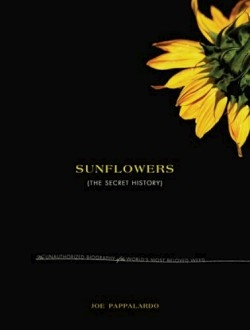
Sunflowers
The Secret History
The sunflower speckles the landscapes of more than forty US states; it decorates our gardens; it appears across world literature; it has driven industrial competition; it has altered our diets. Joe Pappalardo engages readers in the question of the sunflower’s appeal and the full story of its survival. In so doing, his work exposes many unpredicted tales. The story of this ubiquitous wildflower leads the reader through momentous and significant happenings in time and the lives of many intriguing characters. “Natural history binds humanity to its past in ways contemporary humans do not understand.” In this work, the author reveals the bonds attaching the sunflower to humanity, past and future.
Sunflowers are known by their sun-like appearance, their symbiotic relationship with bees, and heliotropism—the way they turn to follow the sun across the sky. But these are commonly known features, and Pappalardo takes us much further. The sunflower has a complex genetic history; like the numerous small flowers that form the united appearance of the sun-like face, the sunflower genus includes many species. It has also endured hybridization and intense genetic branching, which the author chronicles from the archaic period to current developments in genetically modified foods. “Weeds are survivors by nature, and opportunists by trade. These weeds were also pretty—what was built to attract bees caught the human eye as well.” The flower’s simple decorative appeal far from exhausts its utility or motivation for human attention.
The author admits to his obsession with the sunflower that developed through the writing of this work. However, he demonstrates that his attraction is not isolated, and in fact, numerous people have been mesmerized by this botanical specimen. In the first chapter, the author asks, “Is there something deeper that connects mankind with flowers?” A 2005 Rutgers study on the phenomenon of human attraction to flowers is cited in the text; the study found that human emotions are positively influenced by flowers. But it is apparent that this explanation is not a sufficient response to the author’s query; he attempts throughout the book to establish a deeper understanding of the human attraction to flowers, and specifically to sunflowers.
In order to seek a full understanding of the human-flower connection, the author details the many lives of “sunflower people”, as he calls them, who range from farmers, researchers, breeders, and geneticists, to world leaders, and entrepreneurs. The reader will gain insight from the range of examples, including people who have been drawn to the plant through agricultural necessity and symbolic cultural significance. The Hopi Indians honor the flower with a myth that describes the crossing of worlds via a sunflower stalk. Organizations like Affricate have utilized the flower to enliven agricultural development in various African nations. The reader will also follow those driven to hunt the flower with the intention of industrial growth, such as Hitler and Peter the Great.
A final branch of “sunflower people” are those inspired by scientific inquiry and historical knowledge. Scientists such as Charles Heifer and Edgar Anderson, in conjunction with worldwide seed banks, have worked to preserve and record the sunflower’s “secret history,” though scientists are still struggling to completely track the complex genetic history of this plant. Symbiotically “sunflowers have accompanied many major human migrations”; the flower has crossed countless borders including space travel with both NASA’s project HE FLEX and the Apollo program. The book’s subtitle indicates that this work is an unauthorized biography of the sunflower, but the author’s research sheds light on many other stories that intersect with the flower. Through those intersections, the book’s content crosses multiple disciplinary boundaries. Chapters may begin in the style of social history and then transform into a description of mathematical theory. Readers will complete a chapter focused on historical Russia and then proceed to a chapter exploring current day Canada. Pappalardo covers a great deal of material that spans time periods, geography and disciplinary focus; however, the author’s narrative style provides cohesion as does the driving inquiry into human-sunflower connectedness.
Joe Pappalardo is an editor at the Smithsonian’s Air & Space magazine and has published in several newspapers and magazines. He uses his experience as an award-winning journalist to entice the reader via a favorite flower that is a “universal symbol for the peaceful, gentle and friendly,” only to delve into intricate scientific developments and historical events. After moving from the origins of agriculture, to the discovery of the new world, to both world wars and the great depression, the reader will arrive to find a renewed appreciation of the sunflower that will exceed any expectation of its significance to humanity.
Reviewed by
Caroline Sinkinson
Disclosure: This article is not an endorsement, but a review. The publisher of this book provided free copies of the book to have their book reviewed by a professional reviewer. No fee was paid by the publisher for this review. Foreword Reviews only recommends books that we love. Foreword Magazine, Inc. is disclosing this in accordance with the Federal Trade Commission’s 16 CFR, Part 255.
